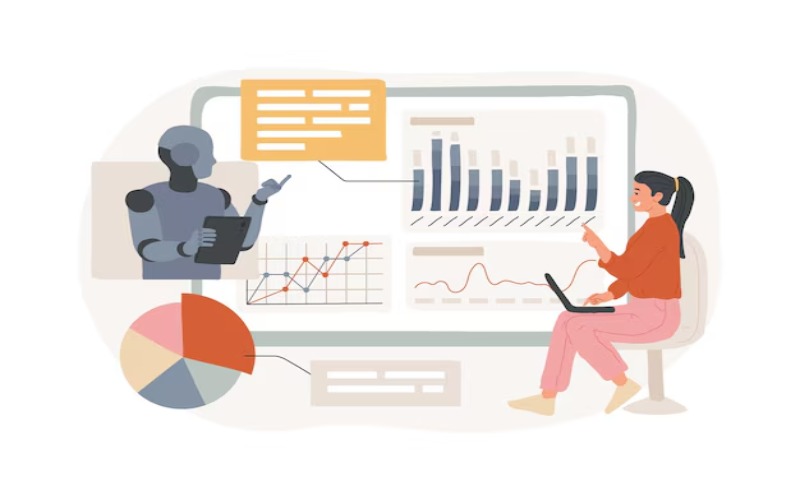Predictive AI is a subset of artificial intelligence that uses past data and machine learning to guess what might happen in the future. Using AI to make forecasts is now more accessible than ever, but businesses need to be extremely careful in designing these models. General AI best practices are just as relevant for predictive models, and they can make the difference between getting a jump on the market or losing a fortune.
Predictive AI works by looking at past data, identifying patterns, and then making forecasts based on current trends. By looking at patterns and connections in big sets of data, these AI models can predict things like customer habits, market trends, equipment breakdowns, and even health issues.
Predictive AI has already been extensively utilized across research, academia, and the corporate and financial sectors, each leveraging its predictive capabilities to drive innovation and efficiency. Examples of this are in our everyday life as well, without us even noticing it – personalized content recommendations on your favorite streaming platforms such as Netflix as well as navigation apps that suggest the best routes based on historic and real-time traffic data for instance.
As predictive AI becomes democratized, however, companies new to the technology need to take precautions. Even with the advances in Generative AI, widescale use of AI Predictive modeling needs to be implemented with care.
When Predictive Models Go Wrong
In 2021, Zillow, an online real estate marketplace, was forced to cut 25% of its workforce because of an error in the AI algorithm used to predict home prices. The predictive model was used to enable the company to make cash offers on properties based on current versus predicted future values.
Zillow said the error in the predictive model had led to unintentionally purchasing homes at higher prices than the predicted estimates of future selling prices, resulting in a $304 million inventory write-down in Q3 2021.
With recent advances in generative and predictive AI becoming evident and the technology becoming more accessible to non-technical users, interest in AI modeling has expanded beyond just Fortune 500 companies to businesses of all sizes. However, as the barriers to entry lower, potential pitfalls arise for those looking to adopt predictive AI. So, what are some of the necessary steps and considerations required to develop AI-powered forecasting?
Accurate Data – Trash in, Trash out
Ensuring the accuracy and trustworthiness of AI-generated data and predictions is crucial, especially given the growing reliance on artificial intelligence. One of the foundational steps in this process is ensuring data quality from the outset. High-quality, clean, and relevant data is essential for training AI models. This is why auditing and reviewing your existing systems and data prior to building a model is crucial.
A common problem in every organization with data is the existence of duplicates and incomplete entries. Oftentimes, data also exists, irreconciled, in multiple systems. These simple errors can badly skew a predictive model and can rapidly make a forecast useless.
Transparent AI – Secret in the Sauce
Implementing transparent AI systems allows stakeholders to understand and trace the decision-making process and is vital for building trust and ensuring that the AI’s outputs can be scrutinized and validated. The workings of Generative AI models in particular are notorious for their murkiness, and knowledge of the system prompts that direct the model is necessary to ensure that the predictive outputs make sense.
Regular validation and testing of AI models against known benchmarks and real-world scenarios is also crucial to ensure their accuracy and this process will help identify any discrepancies and the necessary adjustments required to improve the model’s performance.
Bias mitigation – Leveling the Playing Field
Identifying and mitigating biases in data and algorithms is essential to prevent skewed results that could lead to unfair or inaccurate outcomes. Whilst the heavy lifting can be done by AI when analyzing large historical datasets and synthetic data, human experts are still relied on to review and interpret AI outputs, providing a critical check, especially in applications where accuracy is paramount.
In 2019, a predictive AI model used by a major healthcare system was found to be biased in its predictions of patient health risks. The AI model was designed to identify patients who would benefit from extra medical care, but it systematically underestimated the health risks of patients with lower socioeconomic status.
This bias occurred because the model used healthcare costs as a proxy for health needs. Patients from wealthier backgrounds typically incurred higher healthcare costs, leading the AI to prioritize them over less affluent patients.
Consequently, patients from lower socioeconomic backgrounds, who might have had significant health needs but lower healthcare expenditures, were less likely to be flagged for additional care. This example highlights the importance of carefully selecting and validating the variables used in predictive AI models to avoid unintended biases.
Data Controls & Security
Robust data controls combined with security protocols throughout the AI implementation process are critical. Data should be encrypted both at rest and in transit to protect it from unauthorized access along with implementing strict access control measures to ensure that only authorized personnel can access the data.
Anonymizing sensitive data through techniques like data masking or tokenization helps protect individual privacy. This combined with secure storage solutions, including encrypted databases and secure cloud storage is imperative with considering the use of AI on sensitive or proprietary data.
One of the most notable examples of a data security and data control breach was in 2020 when OpenAI faced a data security issue with its GPT-3 model when a vulnerability in the API allowed unauthorized access to the model’s training data.
This data included a vast amount of text from the internet, some of which contained sensitive or personal information. Hackers exploited the vulnerability to extract and misuse this data, raising serious concerns about the security of predictive AI models and the potential for misuse of sensitive information. In response, OpenAI tightened security measures and implemented stricter access controls. This incident underscored the critical importance of robust security protocols in AI development to protect against data breaches and ensure the ethical use of AI technologies.
Integrating predictive AI into business operations is a game-changer that enables smarter decision-making by forecasting future trends and outcomes based on historical data. This technology optimizes everything from inventory management and customer service to marketing strategies and financial planning. By anticipating customer needs, market shifts, and potential risks, companies can stay ahead of the competition and improve efficiency. Moreover, predictive AI uncovers hidden patterns and insights that humans might miss, leading to innovative solutions and new opportunities.
However, it’s crucial to plan properly at the start, ensuring high-quality data and robust systems are in place. For support in implementing predictive AI and to ensure a smooth and effective integration, contact us today. Adopting predictive AI can result in better decision-making, and cost savings, and give your business a significant competitive edge.











